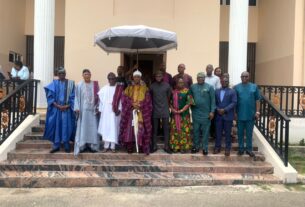Group Chief Executive Officer, McEnies Global Communications, Ms Omolaraeni Olaosebikan, a notable practioner in the marketing communications and event planning space have identified collaboration, cracking down on quacks, presence of a strong regulatory intervention, favorable government policy amongst others as some of the ways to address the challenges in the industry.
The brand management expert also noted that there is a huge opportunity for growth in the marketing communications industry in Nigeria. She said this during a chat with some media executives at Transcorp Hilton hotel, Abuja over the weekend, adding that Nigeria must learn to appreciate professionals for quality service delivery so as to meet the demands of their target audience.
According to her, over 67% of Nigeria’s population is made up of youth and they are digitally inclined and engaged with brands. The huge opportunity for marketing communications professionals is to take advantage of this relevant demography and be able to provide the kind of engagement which the youth can relate and hang on to.
She stated: “You will strongly agree with me that content is an area that holds a huge opportunity for the marketing communications industry. There is no media channel that can produce enough content for this large population of over 200 million people to consume satisfactorily. That is why it’s an opportunity for the marketing communications industry because you can create content; and you have different platforms that you can put them on, which essentially helps the industry to drive its policy thrust.”
Continuing, she said: “An industry stakeholder once said, and I’m also in synch with it, that the time of ‘attention economy’ is gone when you have one too many, that is, one channel to get the attention of millions of people; but now, it is about the ‘attraction economy’, how involved is your target audience? How involved are your people when they engage with you? When you have one person that has access to many screens looking at varying contents, it creates an air for opportunity which means that people can engage; and all we need to do is to be observant.”
Speaking on the challenges envisaged in the sector, Omolara said: “Adapting to the new normal is one of the challenges of the industry. Before the lockdown clients were already beginning to lean towards digital space since they knew that more than 67% of their target audience was in that space”, adding, “In the different engagements we have had as an industry we’ve discussed this situation and I believe that most of my colleagues have taken steps to adapt and transform their structures to suit the new normal, expectedly so.
“The truth is if you are waiting for traditional media to survive that may not happen because the media budget keeps shrinking every day. You can’t sit and think things will work out in that manner, you must always think out of the box and show proactiveness and as well prove your professional mettle to your various clients, and of course that should be your cutting edge. Again the industry must also rid itself of quacks.”
Omolara added that stakeholders in the industry must step up their games to justify their presence and dominance in the noble and much sought after industry and that government policies are also a challenge facing the industry:
“Public Relations has gone beyond sending out press releases to announce brand activities.Agencies need to task themselves on new deliverables around strategy, content, channels, creativity and measurement. PR is all about connecting people with brands through storytelling, so we have to shift the narrative to reflect what people need and want while also setting the right timeline for the deliverables.
Moreover, media plans must be consistently reviewed at every quarter of calender year to meet the contemporary realities. Meanwhile, Federal government also need to help the industry through introduction of favorable policies for the survival and growth of the industry.” Olaosebikan said


